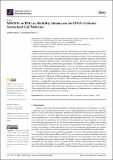Por favor, use este identificador para citar o enlazar a este item:
http://hdl.handle.net/10261/250600COMPARTIR / EXPORTAR:
 SHARE SHARE
 CORE
BASE CORE
BASE
|
|
| Visualizar otros formatos: MARC | Dublin Core | RDF | ORE | MODS | METS | DIDL | DATACITE | |

| Título: | MWNTs or PEG as Stability Enhancers for DNA–Cationic Surfactant Gel Particles |
Autor: | Mezei, Amália CSIC; Pons Pons, Ramón CSIC ORCID | Palabras clave: | DNA PEG Multi-walled carbon nanotubes Composite Release SAXS Stability |
Fecha de publicación: | 16-ago-2021 | Editor: | Multidisciplinary Digital Publishing Institute | Citación: | International Journal of Molecular Sciences 22 (16): 8801 (2021) | Resumen: | Cationic surfactants interact with DNA (Deoxyribonucleic acid), forming surfactant-DNA complexes that offer particularly efficient control for encapsulation and release of DNA from DNA gel particles. In the present work, DNA-based particles were prepared using CTAB (Cetyltrimethylammonium bromide) as the cationic surfactant and modified using two different additives: (Multi-Walled Carbon Nanotubes) MWNT or PEG (Poly Ethylene Glycol). The use of both additives to form composites increased the stability of the gel particles. The stability was monitored by the release of DNA and CTAB in different pH solutions. However, not much is known about the influence of pH on DNA–surfactant interaction and the release of DNA and surfactant from gel particles. It was observed that the solubilization of DNA occurs only in very acid media, while that of CTAB does not depend on pH and gets to a plateau after about 8 h. Within 2 h in contact with a pH = 2 solution, about 1% DNA and CTAB was released. Complete destruction for the gel particles was observed in pH = 2 solution after 17 days for PEG and 20 days for MWNT. The composite particles show a considerably enlarged sustained release span compared to the unmodified ones. The dehydration-rehydration studies show that the structure of the composite gel particles, as determined from SAXS (Small-Angle-X-Ray-Scattering) experiments, is similar to that of the unmodified ones. These studies will allow a better knowledge of these particles’ formation and evolution in view of possible applications in drug delivery and release. | Versión del editor: | https://doi.org/10.3390/ijms22168801 | URI: | http://hdl.handle.net/10261/250600 | DOI: | 10.3390/ijms22168801 |
| Aparece en las colecciones: | (IQAC) Artículos |
Ficheros en este ítem:
| Fichero | Descripción | Tamaño | Formato | |
|---|---|---|---|---|
| ijms-22-08801-v2.pdf | Artículo principal | 2,16 MB | Adobe PDF |  Visualizar/Abrir |
CORE Recommender
SCOPUSTM
Citations
1
checked on 03-may-2024
Page view(s)
59
checked on 16-may-2024
Download(s)
73
checked on 16-may-2024
Google ScholarTM
Check
Altmetric
Altmetric
NOTA: Los ítems de Digital.CSIC están protegidos por copyright, con todos los derechos reservados, a menos que se indique lo contrario.
